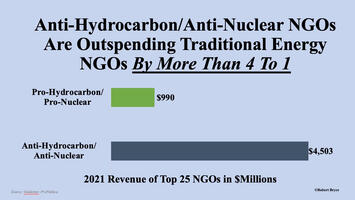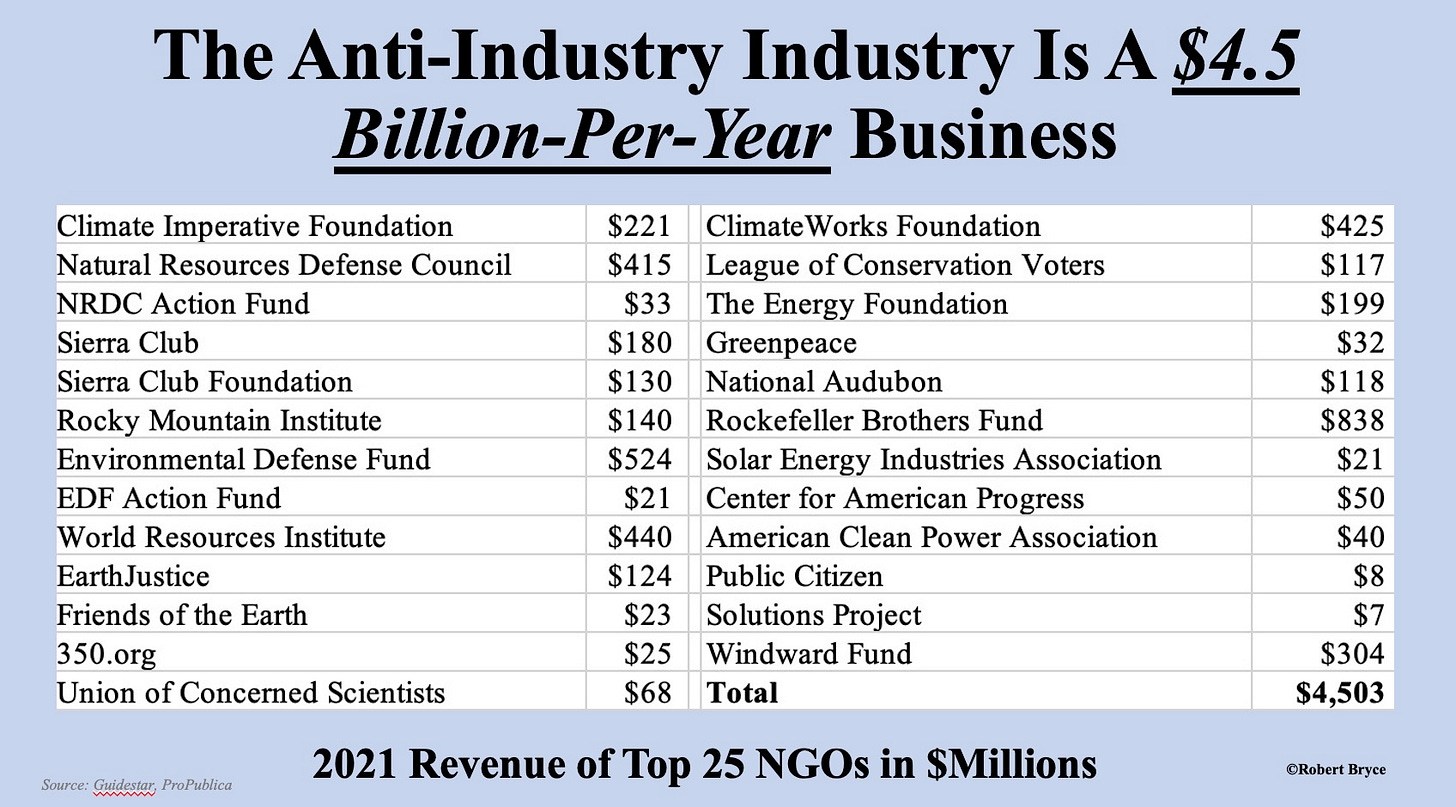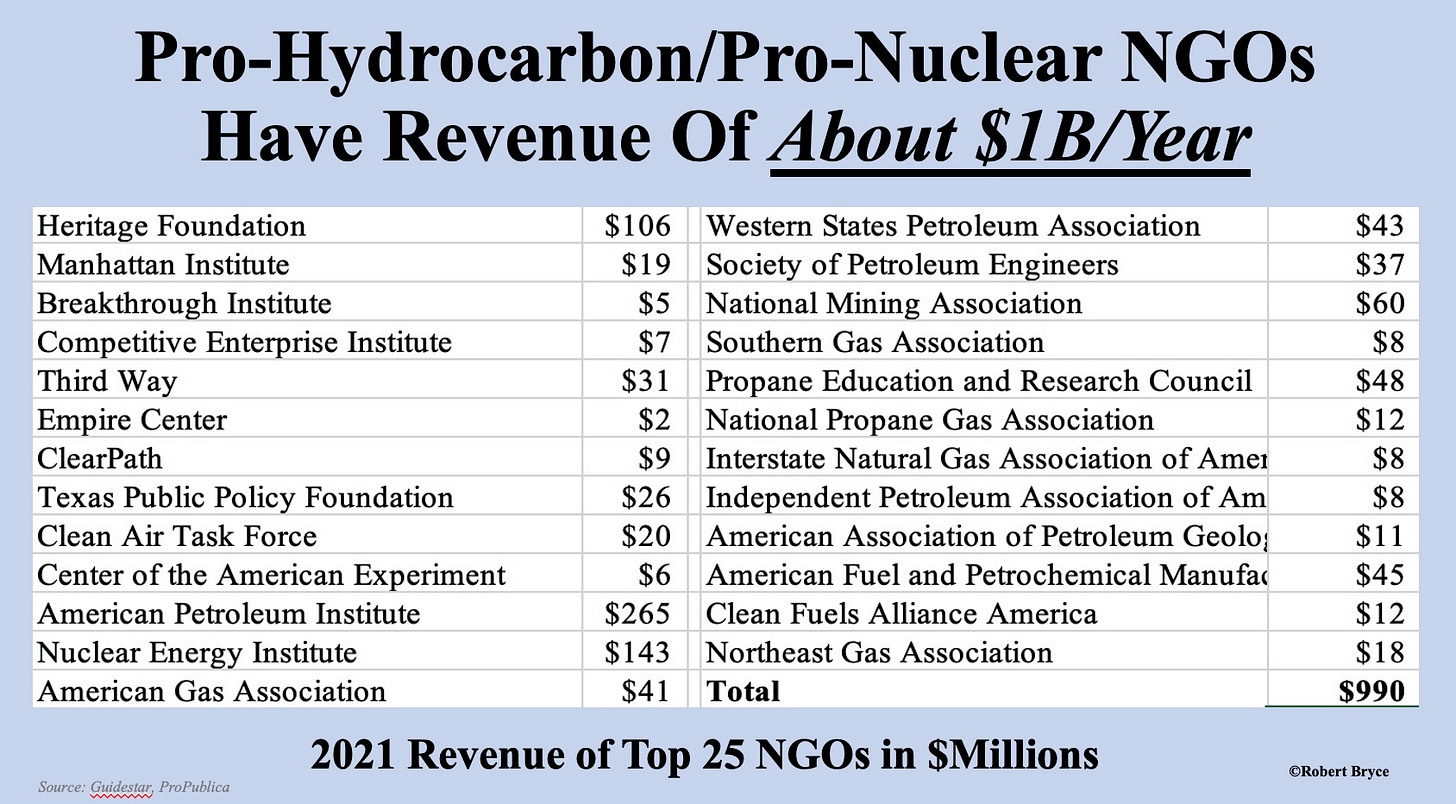
The overwhelming majority of the money involved in the energy and climate debate in the U.S. today is not on the side of traditional energy producers. Instead, the money, the media, and the momentum are clearly on the side of the NGO-corporate-industrial-climate complex.
In 2021, the revenue for the top 25 NGOs in the anti-industry industry was more than four times the amount collected by NGOs that support the traditional energy sector. Those 25 anti-hydrocarbon/anti-nuclear NGOs had total revenue of about $4.5 billion which they used to fund campaigns on climate change, as well as efforts to promote renewable energy, stop the production of hydrocarbons, halt construction of new hydrocarbon infrastructure, prohibit the use of natural gas, oppose nuclear energy, and electrify everything, a move that would require massive increases in electricity production and the size of the electric grid.

The $4.5 billion sum, which I tallied over the past few weeks by compiling data from Guidestar and ProPublica, is more than four times the amount being raised by the top 25 NGOs that are either pro-hydrocarbon or pro-nuclear. In 2021, the top 25 non-profit associations that represent hydrocarbon producers, the nuclear energy industry—along with their allies in the think tank sector—took in about $990 million, or less than one-fourth of the amount garnered by the top anti-hydrocarbon/anti-nuclear NGOs. As can be seen in the graphic above, 14 of the anti-hydrocarbon/anti-nuclear NGOs have annual revenues of more than $100 million. By comparison, as can be seen in the graphic below, only three of the NGOs on the other side of the policy divide have revenues of more than $100 million.
Furthermore, the amount of money being collected by the top anti-hydrocarbon/anti-nuclear NGOs is soaring. Between 2017 and 2021, the amount of cash being collected by the 25 top NGOs—which includes entities like the Sierra Club and Environmental Defense Fund—has jumped by 155%, going from about $1.8 billion to $4.5 billion.
Don’t expect to read about this vast funding disparity in legacy media outlets. Some of the biggest news organizations in America are peddling a manufactured narrative that the growth of renewable energy is being hindered by “front groups” that are getting money from hydrocarbon producers. In December, in The New Yorker, climate activist Bill McKibben claimed “front groups sponsored by the fossil-fuel industry have begun sponsoring efforts to spread misinformation about wind and solar energy.” But McKibben didn’t bother to name a single such group. Also in December, the New York Times published an article that claimed the opposition to wind projects in Michigan included “anti-wind activists with ties to groups backed by Koch Industries.” But the reporter who wrote the article, David Gelles, didn’t provide any names or any proof of any Koch connections. (Gelles did not reply to two emails asking him for proof of his claim.)

National Public Radio has published several articles claiming that rural opposition to renewables is being fostered by opponents who are using “misinformation.” Last year, a San Francisco-based reporter, Julia Simon, published an article that claimed: “some of the misinformation comes from groups with ties to the fossil fuel industry, like the Texas Public Policy Foundation.” (2021 revenue: $26 million). But Simon didn’t provide an example to back up her claim.
Read the rest of this piece at Robert Bryce Substack.
Robert Bryce is a Texas-based author, journalist, film producer, and podcaster. His articles have appeared in a myriad of publications including the Wall Street Journal, New York Times, Forbes, Time, Austin Chronicle, and Sydney Morning Herald.
Graph: courtesy Robert Bryce Substack












